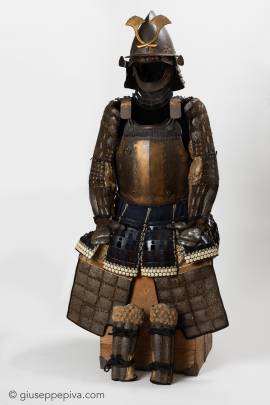TessenFighting fanMid Edo Period (1615 - 1867), Iron, paper with silver-leaf and bamboo.Menhari-gata (opening fan), sensu-gata (enlongated shape)Lenght: 33 cm. - Width open: 54.5 cm.Iron fan with an elegant shape, with nine bamboo ribs.Customarily carried in the hands or tucked in the obi (belt), the folding fan played a significant role in Japanese etiquette, especially on formal occasions, and was rarely ever out of a samurai's possession. Perhaps because it was considered such an ordinary item, it was easily employed as a suitable side arm with only minor modifications....
WORKS FOR SALE
Mid Edo Period (1615 - 1867), Iron, paper with pigments and bamboo.Menhari-gata (opening fan), sensu-gata (elongated shape)Lenght: 31.2Iron fan with an elegant shape, with eleven bamboo ribs.Customarily carried in the hands or tucked in the obi (belt), the folding fan played a significant role in Japanese etiquette, especially on formal occasions, and was rarely ever out of a samurai's possession. Perhaps because it was considered such an ordinary item, it was easily employed as a suitable side arm with only minor modifications. These weapons, called tessen, literally meaning "...
Nanban Tosei GusokuIncorporating a cabasset helmetEarly Edo period, 16th-17th century European armor was brought into Japan through trade with Spain and Portugal in the 16th century. With the introduction of firearms, the Japanese would, in fact, imitate those suits of armor, designed to deflect bullets, and began producing them in Japan, which were collectively called nanban (“Southern barbarian”) indicating a foreign origin.This rare composite authentic Japanese samurai armor incorporates interesting elements made in this style as well as an original European helmet...
Copyright © 2016 - giuseppe piva - VAT: 05104180962










